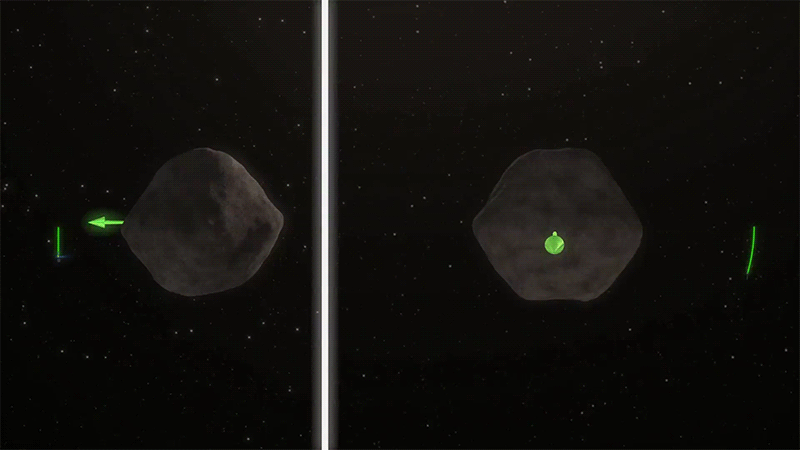Gravity tractor facts for kids
A gravity tractor is a special kind of spacecraft that could help protect Earth from dangerous asteroids. Instead of hitting an asteroid, it uses its own tiny gravitational field to gently pull the asteroid. This way, it can slowly change the asteroid's path.
Even though the gravitational pull from the spacecraft is very small, it can move a much larger asteroid. This works if the spacecraft stays close to the asteroid for a long time. The spacecraft just needs to push its engines in a steady direction. It's important that the spacecraft and its engine exhaust do not touch the asteroid directly. The gravity tractor can either hover near the asteroid or orbit around it. It would aim its exhaust away from the asteroid to create the pull.
This idea has two main benefits. First, we don't need to know much about what the asteroid is made of. We don't need to know if it's solid rock or a pile of rubble. Second, the small forces used allow for very precise changes to the asteroid's path around the Sun. Other methods might need to know the asteroid's exact center or stop its spin. With a gravity tractor, these details don't matter.
Contents
What is a Gravity Tractor?
A gravity tractor is a theoretical spacecraft designed to move objects in space. It uses the natural force of gravity to pull another object. This is usually a potentially hazardous asteroid that might be on a collision course with Earth. The tractor doesn't touch the asteroid. It just uses its gravity to give it a gentle, continuous push.
How Does it Work?
Imagine a very strong magnet pulling a metal object. A gravity tractor works similarly, but with gravity instead of magnetism. The spacecraft has mass, and anything with mass creates a gravitational pull. Even a small spacecraft can create a tiny pull on a huge asteroid. If this small pull is applied for a long time, it can slowly change the asteroid's speed and direction. This is like pushing a heavy car very slowly for hours until it moves a long distance.
Why is it Useful?
When we find an asteroid heading towards Earth, we need a way to move it safely. One big challenge is how to push an asteroid without breaking it apart. If an asteroid shatters, the pieces could still hit Earth and cause damage.
Gentle Push, No Damage
The gravity tractor solves this problem. It gently accelerates the entire asteroid over a long time. It uses the spacecraft's own mass and its gravitational pull to create the needed force. Because gravity affects all parts of an object equally, the asteroid would move as a whole. This means there would be almost no stress on its internal structure. It's like moving a sandcastle by gently pulling the ground it sits on, rather than pushing the sandcastle itself.
Knowing the New Path
Another benefit is that the spacecraft can help us track the asteroid. By constantly watching the spacecraft and asteroid, we can know the asteroid's new path very accurately. This helps make sure the asteroid ends up in a safe orbit, far away from Earth.
Challenges and Considerations
Even with its advantages, the gravity tractor concept has some challenges.
Aiming the Exhaust
One challenge is how the spacecraft's engines push out exhaust. If the exhaust points directly at the asteroid, it could push the asteroid away. This would work against the gravitational pull. So, engineers need to design the spacecraft to aim its exhaust at a slight angle. This way, it can still hover or orbit while pulling the asteroid. This might mean using more fuel.
Working Together: A Global Decision
The gravity tractor method can also lead to complex decisions. When an asteroid's path is changed, the spot on Earth where it might hit could slowly shift. This means that while the threat to the whole planet is reduced, the risk might move to a different country. Deciding how to "drag" the asteroid would require countries to work together. It would be a tough diplomatic decision to make sure everyone agrees on the safest new path.
An Example: A Gentle Nudge Over Time
Let's imagine a NEO about 100 meters wide. This asteroid might weigh a million metric tons. If it threatened to hit Earth, we might need to change its speed by just 1 centimeter per second. This small change would be enough to put it into a safe orbit, missing Earth. This correction would need to happen over 10 years.
To do this, a very small force would be needed, about 0.032 newtons. This is roughly the weight of a few grains of sand. A special spacecraft using an "ion engine" would be ideal. This type of engine is very efficient. It would need about 1,000 kilograms of fuel, like xenon gas, to create this tiny push over 10 years.
To create this small gravitational pull, the spacecraft itself would need to be quite heavy, around 20 metric tons. It would also need to stay very close to the asteroid, perhaps 200 meters away from its center.
The spacecraft could even orbit the asteroid. As long as it stays close, any push from its engines will effectively transfer to the asteroid it orbits. This means the spacecraft can use different ways to hover or orbit. For example, it could orbit the asteroid with its engine exhaust pointing away from the asteroid's center. This would gently "tow" the asteroid, slowly shifting its path away from Earth.


